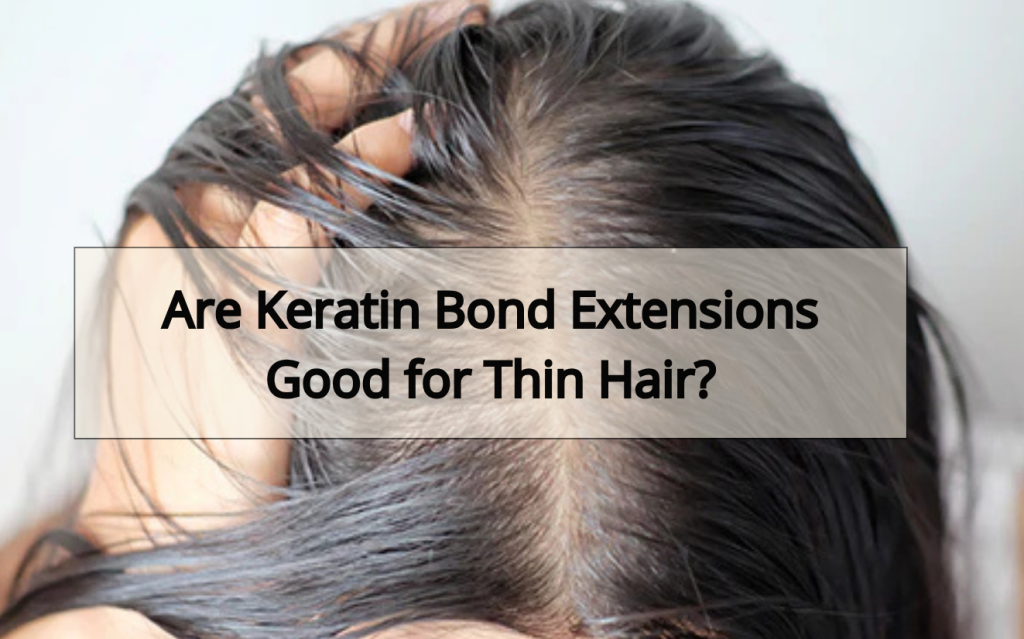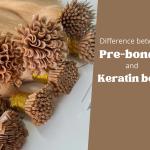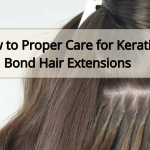Hair Knowledge
Are Keratin Bond Extensions Good for Thin Hair?
For clients with fine or thinning hair, choosing the right hair extension method can be a challenge. While many seek volume, length, and a confidence boost, using the wrong attachment method can lead to tension, damage, or even further thinning. Keratin bond extensions are known for their longevity, natural finish, and strong hold. But are they suitable—or risky—for clients with thin hair? Let’s break it down.
I. What Are Keratin Bond Extensions? (Quick Recap)
Keratin bond extensions are individual strands of human hair that are tipped with a keratin-based adhesive. They are applied strand by strand using a fusion tool (hot or cold), bonding the extension to small sections of your natural hair.
Key Features:
- Nearly invisible flat bonds
- Long-lasting: 6–12 weeks
- Customizable placement
- Requires professional application and removal
🔍 Learn more: What are keratin bond hair extensions?
II. Are Keratin Bond Extensions Safe for Thin Hair?
The short answer: Yes, keratin bond extensions can be safe for thin hair, but only when applied with proper technique, product selection, and after professional consultation.
Let’s explore what makes keratin bonds compatible—or incompatible—with thin hair, and what stylists and clients should watch out for.
✅ When Keratin Bonds Are a Good Choice for Thin Hair
Keratin bond extensions work well on thin hair when applied with precision. The technique involves fusing tiny strands of extension hair to individual sections of natural hair using a keratin-based adhesive. The result is lightweight, flat bonds that lie close to the scalp and are virtually undetectable.
Keratin bonds are ideal for thin hair when:
- The client has uniformly fine but healthy hair, with no active scalp issues or breakage.
- The stylist uses micro bonds (typically 0.5g per strand or less) to reduce tension and weight.
- The installation is done with strategic placement, avoiding high-stress areas like the crown or temples.
- The removal process is done professionally and gently, without pulling or breakage.
👉 Bonus benefit: Because bonds are installed strand-by-strand, they can be customized to match hair density, making them a better match for fine or layered hair compared to tape-ins or wefts.
⚠️ When Keratin Bonds Might Not Be Suitable
Despite their versatility, keratin bonds are not recommended in certain situations:
🚫 If the client has:
- Active hair loss (e.g., alopecia areata, postpartum shedding)
- Fragile or brittle strands that snap under tension
- An excessively oily scalp, which may weaken adhesive bonds prematurely
- A history of sensitivity to adhesives or fusion heat
🚫 Or if:
- They are unable to maintain a proper salon schedule (i.e., visits every 6–8 weeks)
- They frequently swim, sweat excessively, or use heavy oils, which can break down the keratin
In these cases, stylists should consider alternative methods like nano rings, tape-ins, or clip-ins.
What Makes Keratin Bonds Safer for Fine Hair (When Done Right)
The key lies in 3 major factors:
1. Bond Size & Weight
Using smaller bonds (micro or flat tip) reduces strain on the natural hair and scalp. Each bond should be tailored to the hair’s strength and location.
2. Proper Sectioning & Placement
Extensions should be installed with thin, clean sections of hair, with the bond placed at least 0.5 to 1 cm away from the scalp to allow natural movement. Avoiding areas like the hairline or baby hairs helps prevent tension or breakage.
3. Extension Type
For thin hair, it’s best to use:
- Virgin or Remy human hair
- Cold fusion keratin bonds, which require less heat and offer gentler adhesion
- Lighter shades or custom-blended colors to avoid bulky bonds in visible areas
💬 Expert Tip for Salons:
“Always do a strand test before committing to full installation. Observe how the client’s hair reacts to heat, bond pressure, and removal techniques. This will help you choose between hot or cold fusion and determine the ideal bond size.”— N Hair Factory Technical Team
III. Pros and Cons of Keratin Extensions for Thin Hair
Keratin bond extensions offer many technical and aesthetic advantages—especially when precision-installed on fine hair. However, as with any semi-permanent method, they also come with limitations. Understanding both sides is essential for stylists and clients with thin hair to make the right decision.
✅ Pros: Why Keratin Extensions Can Be Great for Thin Hair
1. Natural, Undetectable Appearance
Keratin bonds are applied strand-by-strand, allowing extensions to fall and move like natural hair. The bonds are clear or tinted to match hair color and sit flat against the scalp, making them ideal for fine-haired clients who prefer discreet results—even in ponytails or partings.
2. Lightweight and Customizable
Stylists can use micro bonds (0.5g or less) for minimal tension. Each bond can be customized in density, length, and direction to suit the client’s natural hair structure, ensuring even weight distribution and reducing strain.
3. Long-Lasting Hold
With proper care, keratin bonds can last 6 to 12 weeks per installation. Unlike tape-ins or clip-ins, they don’t require daily removal or adjustment, making them ideal for clients who want a low-maintenance daily routine.
4. Flexible Styling
Because the extensions are individually bonded, the client has full freedom to style their hair—straighten, curl, braid, or even tie up—without exposing any tracks or wefts.
5. No Weft Bulk or Tape Shine
Unlike weft-based or taped extensions, keratin bonds are applied directly to the hair shaft. There’s no bulky band or reflective tape line, which is especially helpful for fine or light-colored hair that can show imperfections more easily.
⚠️ Cons: What to Consider Before Using Keratin Extensions on Thin Hair
1. Risk of Damage if Applied Incorrectly
If bonds are too heavy, too close to the scalp, or applied on weak hair, the weight can cause traction alopecia or breakage. This is especially risky with untrained application or DIY kits.
2. Heat Exposure During Application (Hot Fusion)
Traditional keratin bonding involves heat fusion tools that melt the adhesive tip. While generally safe, repeated heat near fragile strands can increase the risk of weakening or dryness if not done with care.
💡 Alternative: Cold fusion or ultrasonic keratin is recommended for chemically treated or sensitive hair.
3. Difficult to Remove Without a Professional
Keratin bonds require specific removal solutions and tools. Trying to pull them out without professional help can result in hair breakage or loss—especially in thinner hair types.
4. Not Reusable
Unlike I-tip or tape-in extensions, keratin tips are typically single-use. After each removal cycle, the old bonds are discarded and new ones must be installed, making it more expensive in the long run.
5. Time-Consuming Installation and Removal
A full head of keratin extensions can take 2–4 hours to install, depending on the number of bonds and bond size. Removal and reapplication also require time and patience.
6. Oil Sensitivity
Hair oils, serums, and silicone-based styling products can loosen the bond or reduce lifespan. Clients need to follow a strict haircare routine to maintain their extensions properly.
Summary Table: Pros & Cons for Thin Hair
| Pros | Cons |
|---|---|
| Lightweight, discreet bonds | Risk of damage if bonds are too heavy or applied poorly |
| Customizable by section and weight | Requires heat (for hot fusion) – not ideal for very fragile hair |
| Natural movement and styling freedom | Cannot be reused – adds cost per install cycle |
| Long wear without daily removal | Takes 2–4 hours for full installation and removal |
| No bulky wefts or reflective tapes | Sensitive to oils and silicone-based products |
IV. How to Maximize Safety and Results on Thin Hair
1. Use Lightweight Micro Bonds
For thin hair, less is more. Using micro keratin bonds (0.4g–0.6g per strand) distributes weight evenly across the scalp, minimizing pressure on fragile follicles.
- Opt for flat-tip or V-tip bonds with reduced density
- Avoid thick, heavy bonds (above 1g) which can strain roots
- Request custom-bonded extensions from your supplier for ultra-fine hair
💡 Tip: Ask your supplier if they offer custom-drawn bundles for thin hair clients—like N Hair Factory’s lightweight double-drawn keratin options.
2. Strategic Placement Is Key
Placement matters more than quantity when working with delicate hair. Stylists should avoid zones where the hair is weakest or most visible:
- Skip the hairline and crown if density is very low
- Place bonds 0.5–1 cm from the scalp to allow movement
- Maintain consistent tension and partings during installation
- Never overlap or cluster too many bonds in one area
✅ Well-placed bonds create the illusion of fullness without risking scalp trauma.
3. Choose Cold Fusion for Fragile Hair Types
For hair that’s bleached, chemically treated, or naturally brittle, consider cold fusion bonding instead of traditional hot fusion.
- Uses ultrasonic or pressure-based bonding without heat
- Ideal for color-treated blondes or postpartum regrowth
- Produces smaller, softer bonds that blend seamlessly
- Easier to remove and less likely to cause damage during reinstallation
🔍 Look for “ultrasonic keratin” or “soft gel bonds” for cold fusion options.
4. Educate the Client on Daily Aftercare
Aftercare is non-negotiable for thin-haired clients. Even the most delicate bonds can cause breakage if brushed aggressively or treated with the wrong products.
Essential aftercare instructions include:
- Use a soft-bristle or loop brush, brushing from ends upward
- Sleep with hair in a loose braid or silk bonnet to prevent tangling
- Use sulfate-free, lightweight shampoos and conditioners
- Avoid oils or silicones near the bond—apply only mid-lengths to ends
- Gently blot (not rub) hair dry with a soft towel
📌 Quick rule: “Low tension, low heat, low residue” = healthy bonds.
5. Maintain a Strict Salon Maintenance Cycle
Clients with thin hair should return for professional checks every 6 to 8 weeks. This avoids matting near the roots, slipping bonds, and unnoticed damage.
Each visit should include:
- Gentle bond removal with an alcohol-based solution
- Cleaning and re-tipping (if needed)
- Scalp inspection and light trim if breakage is present
- Optional rest period between installs to allow hair recovery
🔁 Encourage 1–2 weeks of rest between cycles every 3–4 months for scalp health.
Final Thought
Are keratin bond extensions good for thin hair?
Yes—but with precision. When applied by an experienced stylist using the right techniques and lightweight bonds, keratin extensions can offer beautiful, long-lasting volume even for fine-haired clients.
However, for extremely delicate scalps or ongoing hair loss, alternative methods may be a safer investment.
💡 At N Hair Factory, we offer customizable keratin bonds in multiple weights, tip sizes, and cold fusion-compatible options—perfect for salons working with all hair types, including fine and sensitive hair.





